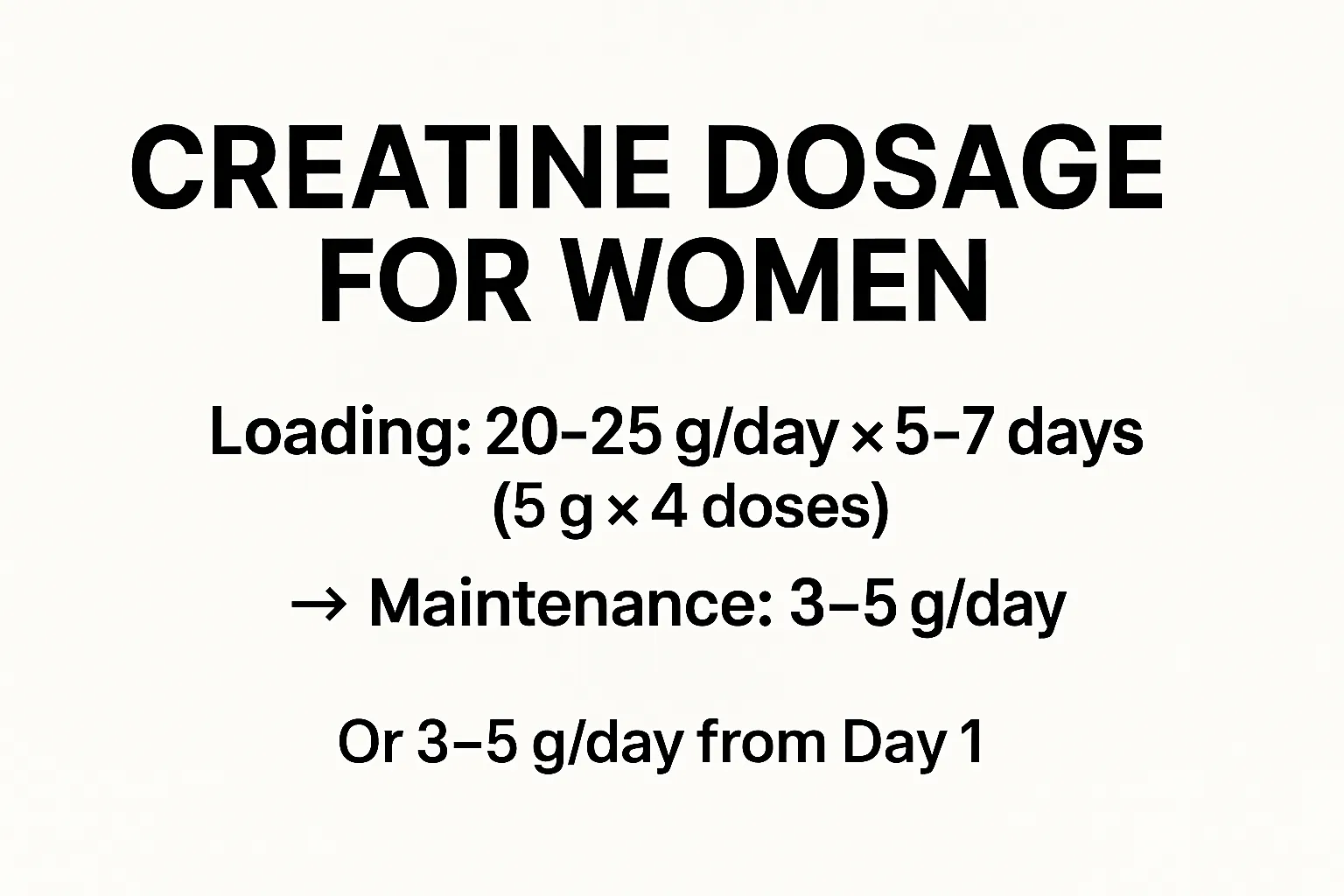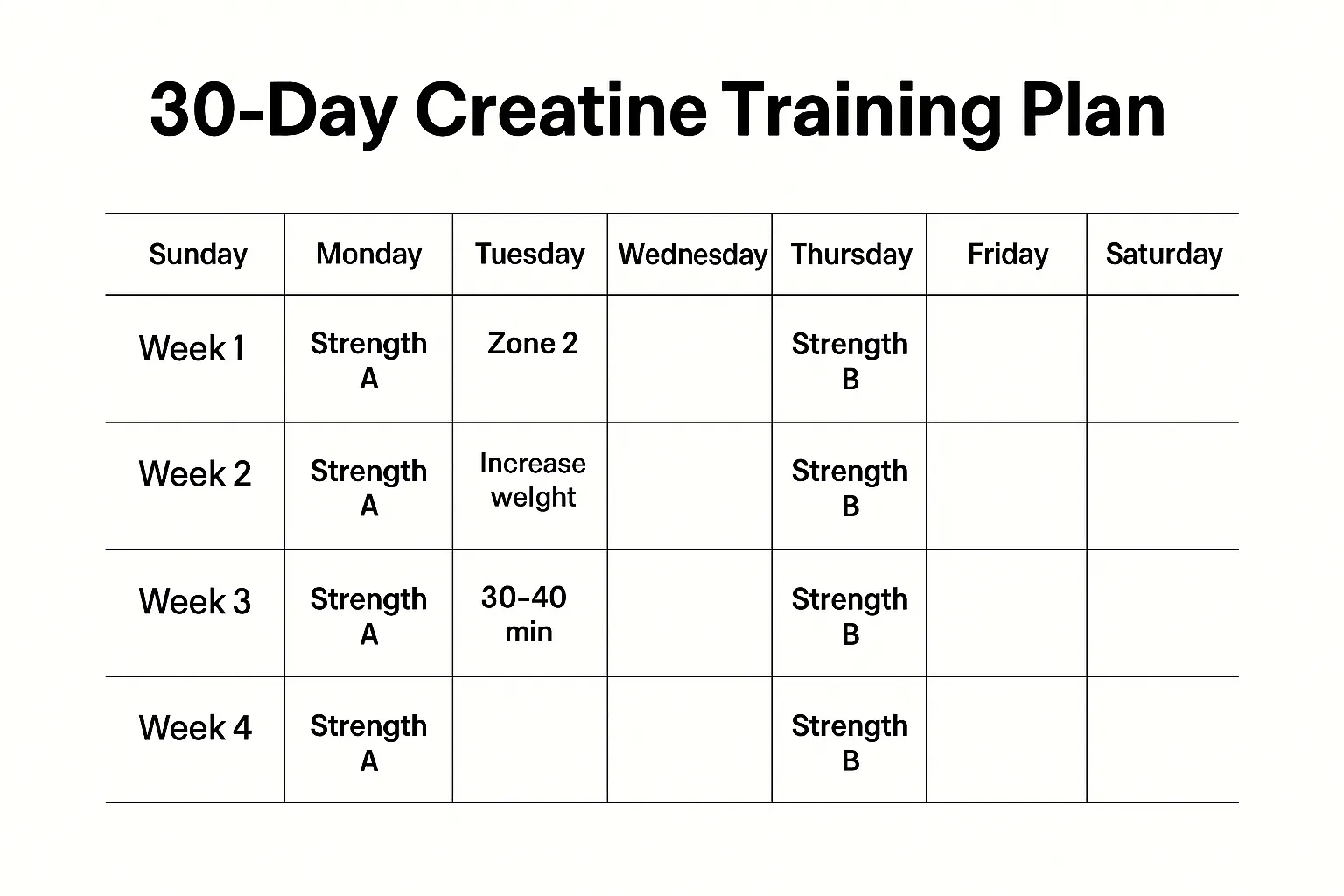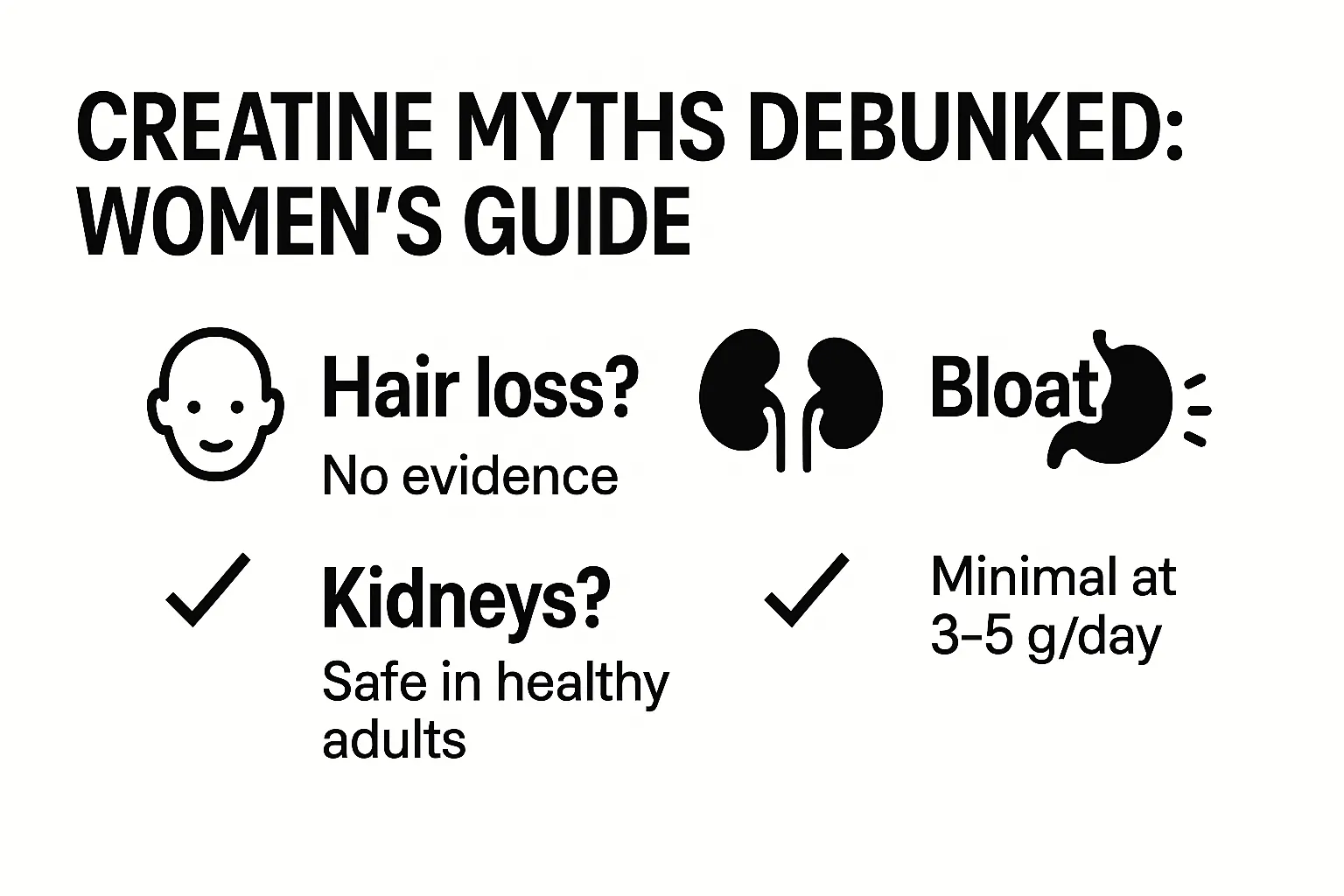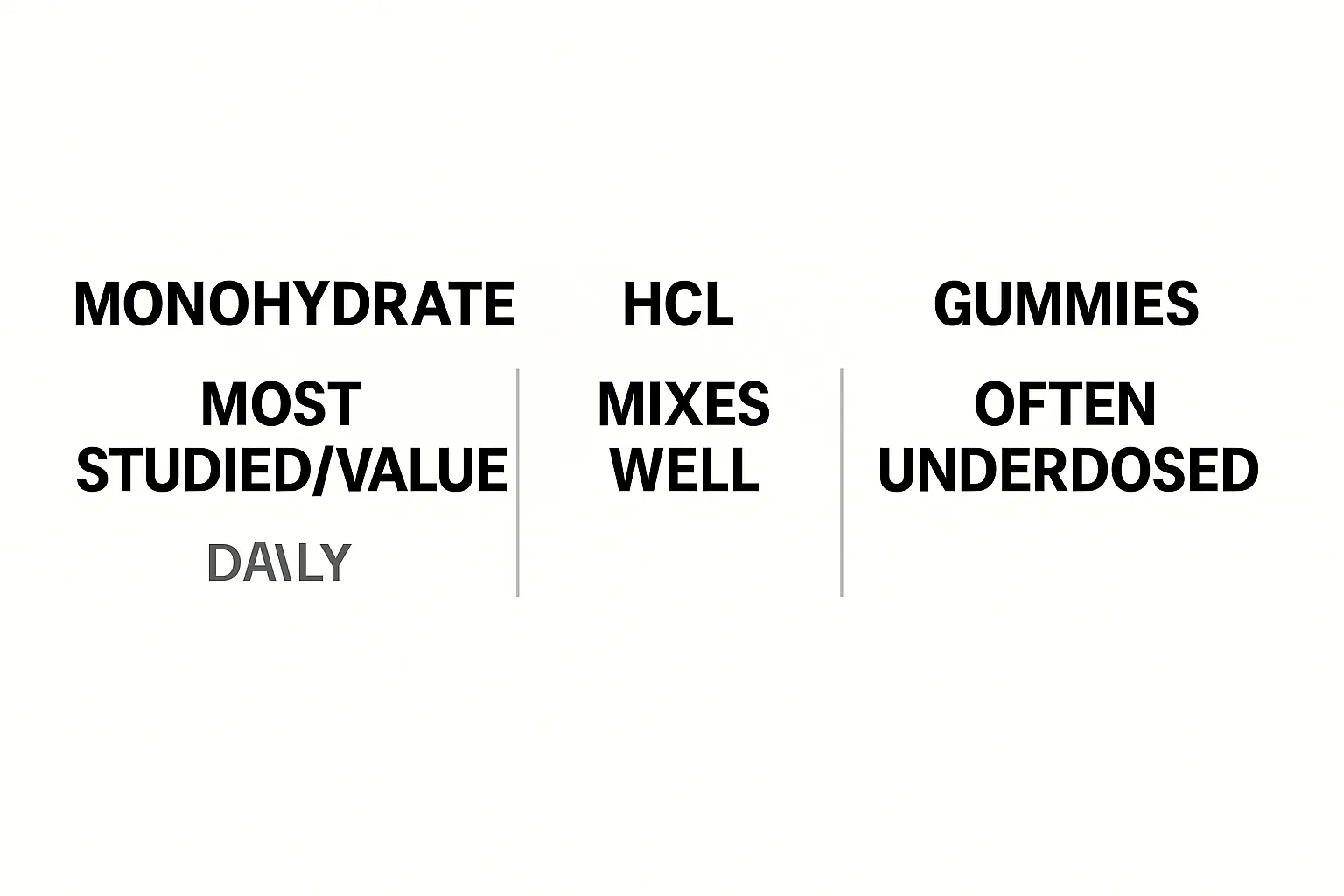Creatine for Women: Dosage, Myths & 30-Day Plan

Creatine for Women Hero
Creatine for Women: Dosage, Myths, and a 30-Day Results Plan
Short version: Creatine for women is one of the simplest, best-studied ways to get stronger, add lean muscle, and feel more powerful in your workouts. It’s inexpensive, easy to take daily, and considered safe for healthy adults when used as directed. Below you’ll find a beginner-friendly 30-day plan, the exact creatine dosage (with and without loading), how to avoid common mistakes, and science-based answers to the biggest myths—like hair loss, bloating, and kidney worries.
Quick Start (Read This First)
- Use creatine monohydrate only. It’s the gold standard in research and the best value. NIH ODS • ISSN position stand
- Dosage: Either load (20–25 g/day for 5–7 days, split into 4 doses) then 3–5 g/day maintenance; or skip loading and take 3–5 g/day from day one. Cleveland Clinic • Examine
- Timing: Take it any time of day—consistency beats timing. With a meal or carbs/protein may help uptake for some.
- Hydrate normally. Aim for steady fluids through the day; no need to overdo it.
- Expectations: Strength usually improves within 2–4 weeks when paired with training; scale weight may rise slightly from muscle+water in muscle, not body fat.
- Type/form: Powder beats gummies (many gummies underdose). Choose third-party tested brands.
- Who should not start without medical advice: kidney disease, pregnancy/breastfeeding, or taking meds where your clinician advises caution. See Safety.
Why creatine for women (and smart beginners)?
Creatine increases your muscles’ rapid energy supply (ATP), helping you push more reps and recover between sets. Over weeks, that often means more lean mass, better performance, and greater training confidence. A lifespan review focused on women reports improvements in strength and exercise performance, with promising lines of research on cognition and healthy aging as well. Women’s health review (PMC). Large evidence summaries and position papers conclude that creatine is effective for high-intensity training and that short- and long-term use is safe in healthy adults. ISSN • NIH ODS.
Creatine dosage (with and without loading)

Two equally valid ways to take creatine for women:
- Load, then maintain: 20–25 g/day for 5–7 days (e.g., 5 g × 4 doses), then 3–5 g/day ongoing. You’ll saturate faster—noticeable strength bumps in ~1–2 weeks. Cleveland Clinic
- No loading: Start at 3–5 g/day and keep going daily. You’ll catch up in ~3–4 weeks. Examine
Pro tip: Stir the powder into any drink or yogurt; micronized creatine mixes easiest. If you split doses during loading, take them with normal meals.
Does timing matter?
Not much. Taking creatine close to your training may be convenient, but total daily intake is what matters most. Pairing with carbs/protein can help some people tolerate it better.
What results to expect in 30 days
- Week 1: If you loaded, you may feel stronger “in the tank” on compound lifts; if you didn’t, you’re building toward that.
- Weeks 2–3: Performance starts to climb—more reps at the same weight or a small load increase. Some see 1–3 lb scale uptick from water stored inside muscle plus lean mass, not fat.
- Week 4: Clearer strength gains: an extra set, a few more reps, or a weight jump on your key lifts. Clothes may feel subtly different at shoulders/glutes from muscle fullness.
A simple 30-day training plan to pair with creatine

This plan focuses on progressive strength with optional Zone-2 cardio. Hit each strength day with control and perfect technique.
| Week | Days | Strength Focus | Cardio |
|---|---|---|---|
| 1 | Mon, Thu | Day A: Goblet squat 3×8–10; Row 3×8–10; DB Press 3×8–10; Hip hinge (RDL) 2×8–10; Plank 2×30s. Day B: Split squat 3×8–10/leg; Lat pulldown 3×8–10; Incline push-up 3×8–10; Hip bridge 3×10–12; Side plank 2×20–30s/side. | 2× 20–30 min Zone-2, non-consecutive days |
| 2 | Mon, Thu | Repeat Week 1, add 1 set to your first two movements if recovery is good. Keep reps crisp; leave 1–2 reps in reserve. | 2× 25–30 min Zone-2 |
| 3 | Mon, Fri | Day A: Squat 3×6–8; Row 3×6–8; Press 3×6–8; RDL 3×6–8; Plank 3×30–40s. Day B: Split squat 3×8; Pulldown 3×8; DB Press 3×8; Hip bridge 3×12; Side plank 3×30s/side. | 2× 25–35 min Zone-2 |
| 4 | Tue, Sat | Technique week: Match your best weights from Week 3 for solid, repeatable sets (no grinders). Optional 1 small load increase if form is perfect. | 2× 30–35 min Zone-2 |
Progression rules: If you finish all sets with great form and still have 1–2 reps “left,” add 2.5–5 lb (or 1 rep) next time.
Myths, answered with evidence

“Does creatine cause hair loss?”
Current evidence does not show that creatine causes hair loss. A widely cited 2009 study in male rugby players found a rise in DHT, but follow-up work and modern reviews do not support a link between creatine and hair loss/baldness. A 2025 randomized controlled trial measuring hormones and hair parameters found no differences versus placebo. PubMed RCT 2025 • Evidence review • MedicalNewsToday overview.
“Will creatine hurt my kidneys?”
In healthy adults using recommended doses, large position papers and federal fact sheets consider creatine safe—including multi-year use—while noting that people with kidney disease should speak with their clinician. NIH ODS • ISSN position stand • Mayo Clinic.
“Am I going to bloat?”
Creatine draws some water inside muscle cells, which is part of how it supports training. Many women don’t notice any visible “bloat”; if you do during loading, cut the loading phase or split doses. Maintenance (3–5 g/day) rarely causes noticeable puffiness.
“Is creatine only for bodybuilders?”
No. More women and adults over 40 are using creatine to support performance and muscle as they age; it’s one of 2025’s most searched, research-backed supplements. Trend coverage.
How to take creatine for women (step-by-step)
- Pick creatine monohydrate powder. Skip proprietary blends; look for third-party testing (NSF Certified for Sport, Informed Choice).
- Decide on loading: If you want faster results, load 20–25 g/day for 5–7 days (split into 4×5 g). Otherwise start 3–5 g/day.
- Take it daily. Consistency matters more than timing; pair with any meal or your post-workout snack.
- Lift twice a week minimum. Creatine accelerates what training signals—use the 30-day plan above.
- Track 2 numbers weekly: best set on your main lift and how many days you hit your creatine dose.
What about different types (HCl, gummies, chews)?

Monohydrate is the most studied and most cost-effective. HCl mixes well but isn’t more effective in head-to-head research. Gummies/RTDs can be convenient but often underdose (check grams of creatine per serving). If a gummy gives 1–2 g, you may need multiple servings to hit 3–5 g/day.
Women-specific notes
- Midlife & menopause: Creatine paired with resistance training may help preserve lean mass and strength as hormones shift.
- Vegetarian/vegan: You may have lower dietary creatine; supplementation can be especially helpful. NIH ODS
- Runners & HIIT: Creatine helps efforts up to ~2 minutes (sprints, hills, finish kicks); it doesn’t directly boost long-endurance performance but can support strength work that makes running more robust.
Safety, side effects, when to avoid
Generally safe for healthy adults at recommended dosages, including long-term—per NIH ODS and ISSN. Mild GI upset is usually dose-related; take with food or split doses. People with kidney disease or other conditions should consult their clinician before use. NIH ODS • ISSN • Mayo.
FAQs
What’s the best daily dose of creatine for women?
3–5 g/day of creatine monohydrate. Load 20–25 g/day for 5–7 days if you want faster saturation, or skip loading and just take 3–5 g/day. Cleveland Clinic • Examine.
Can I take creatine if I don’t lift heavy?
Yes. Creatine supports high-effort bursts in any training (circuits, machines, bands). Pair it with progressive strength work twice a week for best results.
Will creatine make me look puffy?
Most women don’t notice visible puffiness at 3–5 g/day. Any quick “gain” is water inside the muscle and improved training capacity—not fat.
Does creatine cause hair loss?
Evidence to date does not show creatine causes hair loss; a new randomized trial found no differences in hair or DHT vs placebo. RCT 2025 • Review.
Is creatine safe long-term?
Major summaries report safety in healthy adults, including multi-year use. People with kidney disease should not start without medical guidance. NIH ODS • ISSN • Mayo.
What time of day should I take creatine?
Any time works. Taking it with a normal meal can help GI comfort and habit consistency.
Which brand should I buy?
Look for creatine monohydrate with third-party testing (NSF Certified for Sport, Informed Choice). Avoid proprietary “matrix” blends and under-dosed gummies.
Do I need a break/cycle?
No cycling is required. If you stop, muscle stores gradually return to baseline over weeks.
Is creatine helpful for women over 40?
Yes—paired with resistance training, creatine can help preserve lean mass and strength through midlife and beyond. Women’s health review.
More Fitness Guides
Browse our latest strength, cardio, and nutrition how-tos in the Fitness hub.
Sources & citations
- NIH Office of Dietary Supplements — Exercise & Athletic Performance (Creatine safety/effectiveness). ods.od.nih.gov
- International Society of Sports Nutrition Position Stand — Creatine safety & efficacy. JISSN (open access)
- Creatine Supplementation in Women’s Health: Lifespan Perspective (review). PMC
- Creatine loading phase (how & why). Cleveland Clinic
- Creatine benefits/dosage research hub. Examine
- RCT 2025 — No effect on hair parameters vs placebo. PubMed
- Mayo Clinic — Safety overview. Mayo Clinic
Disclaimer: This guide is educational and not medical advice. If you have kidney disease or other medical conditions, or you’re pregnant/breastfeeding, consult a qualified clinician before using creatine or changing your exercise routine.





